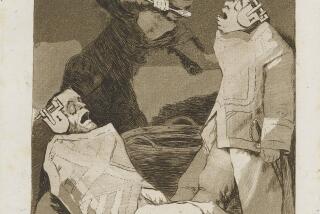Jacoulet Print Collection Reveres His Life, Work
- Share via
Some artists have such colorful personalities their lives threaten to be more interesting than their work. One thinks of Cellini or Gauguin. Another--who never gained their eminence--is Paul Jacoulet, a French draftsman, watercolorist and printmaker who died in 1960. He mostly lived and worked in Japan while traveling the Far East and Pacific Islands.
High on the list of his extant fans is Pasadena’s Pacific Asia Museum, which currently is showing “The Prints of Paul Jacoulet Revisited.” It features the complete run of his 166 wood-block images from their collection. The museum makes it clear that as far as it’s concerned, this artist is among the century’s great unsung. While admiring the courage of these convictions it’s hard to imagine them ever becoming widespread.
Jacoulet’s work compares only dimly to Japanese-influenced European Post-Impressionists like Gauguin, Toulouse-Lautrec or Bonnard. On the other hand, we live in Post-Modern times, when the cannon is being reformulated. It can be reasonably argued that Jacoulet shouldn’t be compared to European prototypes. He’s more like his contemporaries among Japanese artists, who tried to modernize their traditional prints in a movement called shin-hanga.
Jacoulet’s work so thoroughly absorbed traditions of Japan’s “floating world” images it looks more like European-influenced Japanese art than vice-versa. If that only proves that it’s very esoteric at least it proves something.
The most vivid image of Jacoulet comes from a catalog essay by Richard Miles. It describes the artist in old age propped up in a luxurious sickbed, his face lightly downed with rice-powder, his lips tinted with rouge from a handsome old cosmetic case nearby. Miles says the artist’s reason for using makeup was to correct a sallow complexion brought on by delicate health. He comes across like a character invented in a collaboration between Lady Murasaki and Proust, a curious mixture of naivete and decadence.
He was born in 1902 looking “like a damaged little worm” to decidedly alienated parents living in a petit-bourgeois section of Paris. Soon after, his father got a post in Tokyo teaching language to aristocratic Japanese boys preparing for the military.
Jacoulet grew into a young dandy schooled by private tutors. He collected butterflies and ceramics while excelling in art, calligraphy and music. He spoke flawless Japanese and learned the rudiments of English from the American writer Leonie Gilmore, the mother of the renowned sculptor Isamu Noguchi. Jacoulet’s father was called home to fight in World War I. He didn’t survive the struggle.
At 20, Jacoulet took a post at the French Embassy in Tokyo, neglected his art and became something of a playboy. One woman described him as the “best-looking young man” in town. All the same, he never married. Instead, jarred by the disastrous Tokyo earthquake of 1923, he devoted himself to art.
Professionally, he did pretty well but never as well as he pretended. He fibbed about celebrities who collected him and threw tantrums at interested dealers. He had friends and loyal followers but basically he was a loner.
The work is richly decorative and largely detached. It comes off best in landscape views such as “Flowers of Distant Islands,” where pure aesthetic beauty is enough. Dealing with the figure, Jacoulet makes elegant patterns but swaps sentimentality for authentic emotion. “The Substitute, Mongol” depicts an unhappy young woman trying to use her pet bunny as a stand-in for a lost child.
He’s curiously uncomfortable dealing with traditional Japanese subjects but warms slightly when confronted with the beautiful nude natives of the Pacific islands. Even his obvious enthusiasm for these gorgeous people is mantled in cliches about noble savages and lost Edens. His wistfulness has the authentic sadness of someone longing for something he basically doesn’t understand.
In a self-portrait, he looks like a cross between Herbert Marshall and Noel Coward--the embodiment of people lost in their own sophistication. He does better with subtle complexities. “The Geisha Kiyoka” depicts a Eurasian female friend in kimono uncomfortably contemplating a picture of an innocent island nude. The faux geisha seems like a stand-in for himself.
It appears that life was more comprehensible to Jacoulet when viewed as play-acting. Set-up compositions like “The Beggar’s Meal, Seoul, Korea” come off better as theater than acts of empathy. If one can’t embrace this art wholeheartedly, it’s less because of any formal limitation and more because beneath the tinsel and glitter, it’s an art that never found its depths.
*
Pacific Asia Museum, 46 N. Los Robles Ave., Pasadena, to Oct. 19, closed Mondays and Tuesdays, (818) 449-2742.
More to Read
The biggest entertainment stories
Get our big stories about Hollywood, film, television, music, arts, culture and more right in your inbox as soon as they publish.
You may occasionally receive promotional content from the Los Angeles Times.










